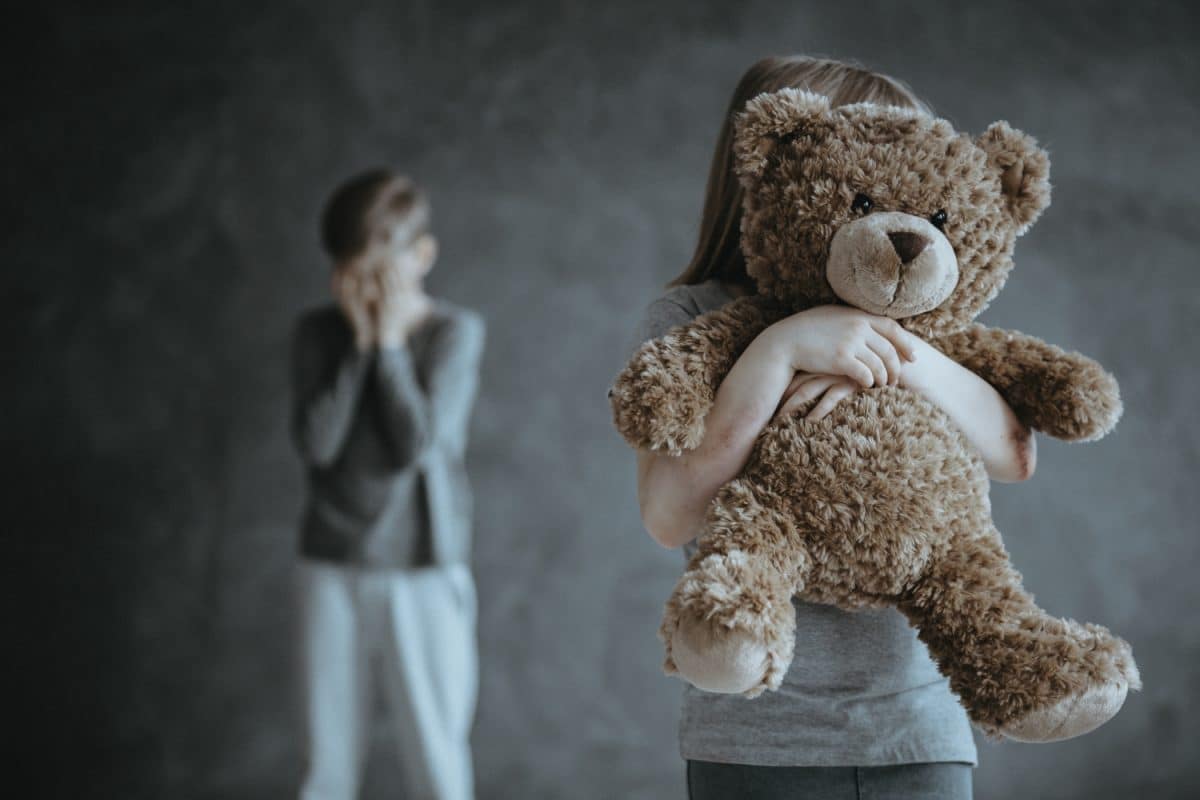There is much evidence to suggest a strong link between dissociation and trauma.
The above is especially true in childhood abuse and neglect cases where dissociative disorders are the most prevalent.
Adverse childhood experiences and dissociation

It appears that dissociation and dissociative disorders are significantly present in those with a history of childhood abuse or neglect, perhaps more so than other mental health disorders.
Many experts believe that long-term trauma is the root cause of dissociation, whereby people develop dissociative disorders as a coping mechanism to help them through a traumatic experience that might otherwise be too disturbing or unbearable.
Prolonged dissociation
Our brains have a fantastic way of helping us through challenging times; for example, the fight, flight, freeze, and fawn mechanism is just one of the ways the brain allows us to get through a traumatic or difficult event.
Stress response
The brain’s stress response gets activated during challenging moments and sends various signals to the rest of the body, which prepares us to fight, flee or freeze in any given situation.
When a stressful event is over, the stress response deactivates, and the body resumes normal functioning.
However, in severe or unprocessed trauma cases, ordinary functioning becomes impaired. As a result, the individual may become “stuck” in their trauma, where they will likely continue to experience stress symptoms despite no evidence of a threat.
What is dissociation?
Dissociation occurs as a way for someone to distance themselves from a trauma and can be helpful during a traumatic event.
However, problems may arise when a person’s dissociation continues despite a lack of danger or threat to life.
Moreover, dissociation can disrupt or prevent recovery from childhood neglect and abuse. Researchers believe that there may also be a link between dissociative disorders and the mental health condition PTSD (post-traumatic stress disorder).
What are the signs and symptoms of dissociation?
It might be pertinent to highlight the differences between dissociation and dissociative disorders since both conditions have distinct signs and symptoms.
Dissociation

All of us have experienced dissociation at some stage; if you’ve ever found yourself zoning out in the middle of class or daydreaming while driving on the motorway, you have experienced dissociation.
Essentially, experts describe dissociation as a disconnection between an individual’s feelings, thoughts, perception, behaviours, and sense of self.
Some experts describe the above experience as “normal” dissociation.
Dissociative disorders
However, like most mental disorders, dissociation may become a severe problem when it interferes with a person’s daily functioning, for example, relationships and work.
Dissociative disorders include dissociation that impairs a person’s ordinary functioning, a condition that affects roughly 2% of the population.
Additionally, dissociative disorders affect people from all backgrounds, ages, socioeconomic backgrounds, and ethnic groups.
Studies show that dissociative disorders are diagnosed in women more often than men; however, this might be due to men not seeking help for their trauma symptoms and other conditions.
Symptoms
If you think you may have symptoms of a dissociative disorder, you must speak to your doctor or mental health professional for advice and treatment.
Early intervention may improve your symptoms and condition and help you feel better sooner. Typically, the symptoms of a dissociative disorder involve:
- Feeling as though you do not belong in your body (feeling detached), you may feel like you are watching yourself in a movie and feel disconnected from your body and surroundings.
- Emotional detachment
- Memory loss, you may not remember people, places, or specific events.
- Relationship issues, problems at work, depression or anxiety, and thoughts of self-harm -are the consequences of a dissociative disorder.
- A weak identity and lack of sense of self
Is dissociation a coping mechanism?

In environments where abuse, neglect, or trauma are rife, dissociation is believed to be a coping mechanism, a survival technique whereby children (or adults) transition into a dissociative state to avoid having to experience an unbearable or disturbing event.
Researchers explain that dissociation is especially common in children; a child cannot escape an abusive or traumatic environment. They are helpless to do anything about the trauma. Thus the only way to escape is to disconnect, which may allow them to cope.
Experts say that derealisation may also occur during dissociation – a state where the child experiences their reality as a dream. In this condition, the child may feel as though nothing is happening to them.
The link between trauma and dissociation
Much research supports the significant link between dissociation and trauma.
Moreover, experts report that people with dissociative disorders have the highest adverse childhood experiences, such as neglect and abuse, compared to other mental illnesses.
The link between dissociative disorders and childhood trauma is so profound that many experts are confident that dissociation is a direct response to severe trauma.
Risk factors
Matthew Tull, Ph.D., a researcher at VeryWell mind, reported that ongoing trauma, primarily childhood physical, sexual, or emotional abuse (and neglect), are significant risk factors for the development of dissociative disorders.
Moreover, adverse childhood experiences are believed to be the root cause in at least 90% of people with dissociative disorders (Matthew Tull, Ph.D., VeryWell mind, June 3rd, 2020).
Tull also said dissociative disorders are linked with the highest frequency of childhood abuse and neglect of all psychiatric disorders (Matthew Tull, Ph.D., VeryWell mind, June 3rd, 2020).
Matthew Tull further explained that while childhood abuse and neglect are factors for dissociative disorders, a single, catastrophic traumatic event in children or adults may also be a risk factor.
Types of dissociative disorders
According to the research literature, there are several different types of dissociative disorders – they include:
- Dissociative fugue – involves having no memory of an event or time frame of what occurred.
- Dissociative amnesia – a prevalent disorder that affects memory loss mainly about significant events or periods in the individual’s life
- Dissociative identity disorder – involves identity changes and confusion where an individual’s personality “splits” and shifts between one or more different characters – the condition used to be called Multiple Personality Syndrome.
- Derealisation/depersonalisation – someone experiencing depersonalisation may feel disconnected from their body and surroundings. The person may feel like they are “floating outside their body”. Derealisation is the sensation of being detached from one’s surroundings and may occur alongside depersonalisation.
What age groups are the most affected by dissociation?
Broadly, experts state that the severity of a dissociative disorder is associated with the severity of childhood neglect or abuse.
With such measures in mind, it is clear that children of specific age groups are more at risk of developing dissociative disorders as a direct response to trauma.
Studies show that the most at-risk groups include children between the ages of four and five. Pre-adolescents between eight and nine are also at risk of developing dissociative disorders.
Dissociation and other conditions
Dissociation may also be linked to other conditions, such as PTSD (post-traumatic stress disorder).
Mental health experts state that PTSD and dissociation are significantly connected and often co-occur; although many believe that the conditions are similar, the two disorders have different symptoms.
Primarily, PTSD develops from a single trauma, such as exposure to a war or a natural disaster; children and adults may develop PTSD due to a traumatic experience.
One of the critical differences between dissociative disorders and PTSD is that PTSD is less dependent on factors like age or the severity of trauma.
On the other hand, the type of trauma that may induce a dissociative disorder relies on the severity of a person’s trauma and age. Inherently, dissociative disorders originate from chronic trauma and stress in one’s childhood, not adulthood.
Dissociative disorders result from chronic childhood trauma, such as physical, sexual, or emotional abuse.
Also another distinguishing factor is that people with typical PTSD have less trauma avoidance than those with dissociative disorders.
Self-protection

If you look at dissociation as your brain’s way of trying to protect you, you may get a better understanding of the condition.
Your brain does not want you to relive a traumatic experience, so it does all it can to mask what happened.
We have all gone through challenging times in life, such as loss and heartbreak, but not everyone knows what it means to experience trauma.
In the aftermath of a traumatic event, it can feel like your whole world has been ravished; people, places, and situations that once felt safe, no longer offer the same security and comfort.
It may feel as though your entire world has been flipped upside down after a traumatic experience, and you may question your self-worth, beliefs, and faith.
When trauma violates all that you once knew to be safe and trustworthy and replaces your sense of safety with physical and emotional shock, your brain reacts to such a violation by jumping into action.
Trauma reactions
Our reactions to trauma can often be helpful, mainly in moments of crisis.
For example, dissociation preserves and protects us during challenging periods; it allows us to survive whatever is happening in the present, but when do conditions like dissociation become something that needs treatment?
If we conceptualise dissociation as a break from reality, an escape from events outside our control, we may get a clearer picture of how the condition presents.
Dissociation is an involuntary detachment from reality, which the survivor experiences as a disconnect from the self, memory, and thoughts.
It is one of the oldest defence mechanisms that human beings unconsciously adopt when they are psychologically overwhelmed.
The human body’s mechanisms are profoundly attuned to its surroundings. In times of severe stress, sometimes safety cannot be met at that time by external surroundings, and when this occurs, we shift to seeking protection internally.
When the world feels unsafe, and outside our control, we intuitively turn to our inner worlds for comfort and safety.
Dissociation is a survival mechanism, and when something terrible happens, your nervous system takes over to protect you from physical and mental pain.
Treatment is required for those who experience nervous system arousal despite a lack of threat or danger to life.
Treatment

Fortunately, effective treatment options are available to those with dissociative disorders.
Proper treatment and support make a recovery from dissociation, PTSD, and childhood trauma possible. Treatment for dissociation often includes a mixture of psychotherapy and prescribed medications.
Therapy options for dissociative disorders include cognitive behavioural therapy (CBT) and dialectical behaviour therapy (DBT).
Treatment may involve confronting any traumatic memories that might be causing you distress in a safe space and facing experiences that present no danger but may remain unresolved due to dissociation.
Contact us
If you want further information about the contents of this article, contact the team at White River Manor today, who can help.
Helpful resources
- Links Between Trauma, PTSD, and Dissociative Disorders: Verywell mind, Matthew Tull, Ph.D., June 3rd, 2020
- What’s the Link Between Trauma and Dissociation?: Psychcentral, Hope Gillette, August 2nd, 2021.







